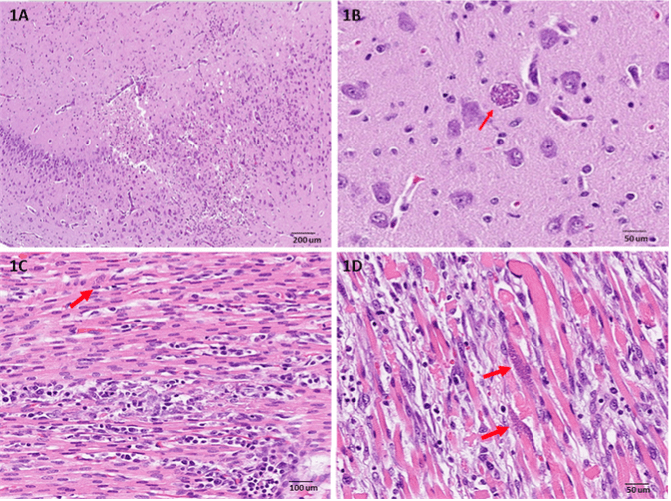Fetal loss and neonatal mortality due to Neospora caninum in a litter of German Shorthaired Pointers
Gaya Balamayooran, DVM, PhD, DACVP and Cheryl Maguire, DVM
A litter of twelve German Shorthaired Pointer puppies whelped near their due date and included one mummified fetus and two stillborn puppies. One puppy died at one week of age, another died at two weeks of age, and two more were lost at three weeks of age. The remaining puppies had a poor suckle reflex and were having difficulty nursing. They also developed a cough and neurological signs.
The breeder was concerned for canine herpesvirus (CHV) and the serostatus of the dam prior to breeding was unknown. One of the three-week old deceased puppies was submitted to the Texas A&M Veterinary Medical Diagnostic Laboratory (TVMDL) for necropsy and additional testing. The cause of death was not obvious on gross necropsy. Gross lesions associated with CHV were not observed but fresh liver was tested via Canine Herpesvirus Type 1 (rtPCR) and CHV was not detected. Histology demonstrated necrotizing encephalitis, lymphoplasmacytic myocarditis, rhabdomyositis and pneumonia with protozoan cyst in the brain and intralesional tachyzoites in several tissues. These findings were consistent with systemic protozoal disease. Neospora caninum was detected in brain/heart tissue pool via (rtPCR) with a Ct Value of 24.70.
CHV antibodies were detected in the dam’s serum at the 1:16 dilution via virus neutralization testing.

Figure 1. (A) Neuropil of the cerebrum is distorted by necrosis and reactive gliosis. (B) A protozoan cyst is present within the neuropil of the cerebrum unassociated with inflammation (red arrow). (C) Myocardium is affected by necrotizing inflammation with variable degenerative changes in the cardiomyocytes and intralesional intracellular tachyzoites (red arrow). (D) Skeletal myocytes are disrupted by inflammation and degenerative changes with intralesional intracellular tachyzoites (red arrows). Hematoxylin-Eosin stain.
Neospora caninum is an apicomplexan coccidian intracellular parasite that is found world-wide. This parasite has an indirect lifecycle in which canids are the definitive host and many herbivore species (cattle, sheep, deer) can serve as the intermediate host. Transmission occurs when canids ingest infected tissues and subsequently shed infected oocysts that contaminate feed, water or soil that can serve as a source of infection for herbivores. Transplacental transmission could occur in infected pregnant bitches which could affect the litter as observed in this case.
Neospora caninum is a common and economically important cause of fetal death and abortion in Texas cattle; but as this case illustrates, neosporosis can also be devastating to individual litters of puppies. Transplacental transmission is an important route of natural infection. Typically, puppies begin showing clinical signs around 3-9 weeks of age. Clinical signs in puppies could include progressive paralysis, inability to nurse, vocalization, respiratory distress, and neurological signs among others. Dogs typically do not show signs of infection. This case is unusual in regards to the fetal loss and early mortality which caused concern on the part of the breeder for CHV. The dam’s low positive CHV titer indicates previous past exposure not necessarily active infection; yet concurrent active CHV infection in the dam cannot completely be ruled out in this case. A full necropsy with additional testing was crucial to providing this client with a diagnosis and information regarding preventing future losses in her kennel.
To learn more about this case, contact Dr. Gaya Balamayooran, pathologist at the College Station laboratory, or Dr. Cheryl Maguire, veterinary diagnostician at the College Station laboratory. For more information about TVMDL’s test offerings, visit tvmdl.tamu.edu or call one of the agency’s full service laboratories.
References
Canttle, C., Youssef, S., Nerveous system. In G.M. Maxie, (Ed), Jubb, Kennedy, and Palmer’s Pathology of Domestic Animals (volume 1). Missouri, St Louis: Elsevier. pp 387-389